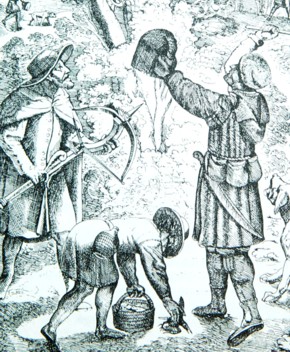Ballistics of the Bullet-Shooting Crossbow
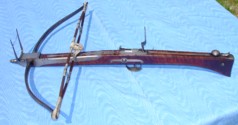 This photograph (click on it for a large
picture) is of a bullet-shooting crossbow made by J. Johnson of Manchester in about 1800. Note the relatively
thick steel bow and characteristic double string with a central pouch. The bow was sighted using a bead
suspended across a cross-tree front sight and a rear peep sight. Note that the strings are made up of multiple
strands of waxed linen and are about as thick as a pencil. I don't know the tensile strength of the
strings, but I estimate it to at least half a ton; even in this partially-tensioned position, the strings are
under so much tension they feel like iron rods.
This photograph (click on it for a large
picture) is of a bullet-shooting crossbow made by J. Johnson of Manchester in about 1800. Note the relatively
thick steel bow and characteristic double string with a central pouch. The bow was sighted using a bead
suspended across a cross-tree front sight and a rear peep sight. Note that the strings are made up of multiple
strands of waxed linen and are about as thick as a pencil. I don't know the tensile strength of the
strings, but I estimate it to at least half a ton; even in this partially-tensioned position, the strings are
under so much tension they feel like iron rods.
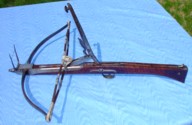 Here, the cocking lever has been pulled up so
the loop of the bowstring can be engaged on the tumbler. The string must be pulled back about 1/2 - 1 inch,
which tensions the strings and slightly closes the pouch so the ball is held in place. This typically takes a
moderate amount of pull (about 50 pounds) just to move the string back this tiny distance.
Here, the cocking lever has been pulled up so
the loop of the bowstring can be engaged on the tumbler. The string must be pulled back about 1/2 - 1 inch,
which tensions the strings and slightly closes the pouch so the ball is held in place. This typically takes a
moderate amount of pull (about 50 pounds) just to move the string back this tiny distance.
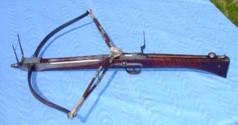
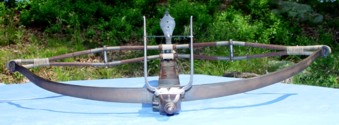 To cock the bow, the lever is forced down until it engages the latch at the rear of the stock, giving the
bowstring about five inches of total travel from its initial position.
To cock the bow, the lever is forced down until it engages the latch at the rear of the stock, giving the
bowstring about five inches of total travel from its initial position.
So how well does it shoot?
The original "manufacturer's recommendations" call for the use of a 1/2 ounce lead ball, which works out to about .53 caliber. I shot a series of balls from .35 to .67 caliber through an Oehler P35 chronograph to determine which gave the most energy and/or which gave the best performance in terms of power and speed. In a stored-energy system like a crossbow (or a muzzleloader), there is an optimum projectile weight to provide the maximum transfer of energy from the stored energy to the projectile. Another way of looking at this is if the projectile is too light, even though it may travel faster, it won't have as much energy as a slightly slower but much heavier one. On the other hand, if the projectile is too heavy, the efficiency will also drop off, and even if more energy is delivered, it will be too slow to be useful (no matter how much energy it has, throwing a bowling ball at a bird is not likely to be effective). The table below summarizes the results.
| Caliber | .350 | .433 | .490 | .530 | .672 |
|---|---|---|---|---|---|
| Weight (gr) | 64 | 122 | 171 | 223 | 455 |
| Ave. Velocity | 155 | 151 | 149 | 145 | 130 |
| Energy (fpe) | 3.4 | 6.2 | 8.7 | 10.5 | 17.2 |
As can be seen, the maximum energy comes from the heaviest ball, but the already low velocity has begun to drop off, so the original recommendation of a 1/2 ounce ball is probably optimum. At a little over 10 fpe, the bow has the energy of a medium-powered pellet gun. The terminal ballistic characteristics, however, are wildly different. The pellet gun, shooting about a 10 grain pellet at about 700 fps, will definitely penetrate skin and if placed just right, will kill a squirrel or rabbit. The bow's bullet is travelling so slow it won't penetrate a person's skin, but it would easily fracture your skull or internally crush a bird or squirrel. The bullet makes an impressive 'smack' when it hits anything!
What about accuracy?
There is a classical book: "The Crossbow", by Sir Ralph Payne-Gallwey, which is the definitive reference for anyone wanting in-depth knowledge of the subject. The bow shown here was re-strung using the instructions in his book. He was the acknowledged authority on the subject and states that one should be able to "hit a playing card eight times out of ten at 25 yards" using this type of crossbow. He also says they were mainly used for killing rooks (crows), which involves shooting up into a tree at a high angle, where the "rainbow" trajectory of the crossbow would not be so much of a problem. I have not sighted in or tested my accuracy with this crossbow, but I will post a target when I have done so.
But Is It Better Than a Slingshot?
To see if it is any better than a 'modern' slingshot, I chronographed a Crossman Marksman slingshot with lead balls of various sizes. This slingshot is one of those with surgical rubber tubing propulsion and a grip which slips over the wrist.
| Caliber | .310 | .350 | .433 | .490 | .530 |
|---|---|---|---|---|---|
| Weight (gr) | 45 | 64 | 122 | 171 | 223 |
| Ave. Velocity | 151 | 163 | 142 | 137 | 135 |
| Energy (fpe) | 2.3 | 3.8 | 5.5 | 7.4 | 9.1 |
As you can see, although the slingshot does not deliver quite the same consistency, it is almost as powerful.
Conclusion
The bullet bow is slightly more powerful and much easier to aim than a modern slingshot, but the antique bows are at least a hundred times more expensive, not counting restoration costs. They are a great conversation item at a shoot, but for performance against their expected prey of rabbits and crows, a modern air gun is as powerful, as quiet, and vastly more accurate.
